Vacuum cleaner testing description
Last Updated: 09/17/2010
|
|
Vacuum cleaner noise, suction, airflow, power consumption testing by GoodVac.com.
|
Disclaimer:
Tests described below are done in our shop and are setup to our best knowledge and judgment. None of us hold a degree in acoustics, aerodynamics or physics. These tests may not be setup the same way other testing laboratories would so results may or may not coincide with results of other testing agencies or data in manufacturers specification sheets. |
| NOISE LEVEL |
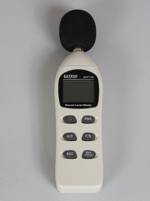 |
- Equipment used - "Extech 407730" Sound Level Meter
- General info - human noise perception has a lot to do with personal perception. People are different when it gets to sensitivity to different sound frequencies. However for testing purposes there had to be a standard so "A-frequency weighting" was developed that addresses and weight importance of certain frequencies to a human ea so we used "A frequency weighting" for every vacuum tested.
- Experiment setup - Sound is being absorbed by carpets and upholstery, dissipated by furniture in the room due sound waves bouncing in different directions and loosing their power faster. Flat hard surfaces bounce sound waves back and forth so when you clap your hands in an empty room with hardwood floors you can hear echo. Sweepers are being tested in the same room hence room size and surfaces are being held equal.
Few common noise levels:
- 20-30 dB - Sound studio
- 30 dB - whisper
- 40 db - night in residential area
- 50 dB- residence
- 60 dB - large store
- 70 dB - average vacuums operate around 70 dB
- 80 dB - pneumatic drill
- 90 dB - subway
- 100 dB - chainsaw
- 110 dB - riveting machine
- 120 dB - jet taking off
|
|
| POWER CONSUMPTION |
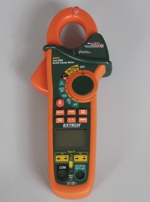 |
- Equipment used - "Extech 623 " Clamp Meter
- General info - how much electricity does the vacuum draw is important for a few reasons:
- Cost of operating the vacuum
- If power supply is sufficient to run the vacuum - important for those who use generators or alternative power supply that may have very limited capability (solar, wind).
- Calculations - On electricity bill you see that you are being charged for kWh - Kilowatt hours. There may be different rates you pay depending upon the time of day and depending on how much electricity you use. There are also various fees and taxes you pay so we suggest simply taking your electricity bill total and dividing by kWh used.
To calculate kilowatts we must know:
- Amperage - How many amperes our vacuum cleaner draws
- Voltage - USA electrical outlet in the wall will have 120 volts and it will vary from country to country
Here is how it is being calculated:
- Measure amperes and multiply them by volts. The result will be watts (amps x voltage = watts)
- One kilowatt is 1000 watts so we need to divide watts by 1000 (watts/1000 = kilowatts)
And when we use one kilowatt for 1 hour we get 1 kWh. Just working backwards - 1kwh would be used by a 8.33 A motor running for 1 hour.
Example -say we have 10 amp vacuum that we use once per week for 1 hour. To calculate our yearly cost we need:
- 10 amperes x 120 volts = 1200 watts
- 1200 watts /1000 = 1.2 kW
- There is 52 weeks in a year so using the vacuum 1 hour per week it will consume 1.2 kW * 52 = 62.4 kWh (kilowatt hours)
- Our shop last months bill was 273.30 and we have used 2053 kWh so our cost is $0.133 per kWh.
62.4 kWh multiply by cost 0.133 = $8.30 is the estimated total yearly cost of using our vacuum cleaner
- Experiment setup - we let the vacuum work for a few minutes to bring it to operating temperature and then using the clamp meeter measure amperage
A regular 60 Watt light bulb I have just tested (light watts should not be confused with watts of power) uses 0.47 amps so when you use a vacuum that draws 10 amps of power this is the same as having 21 sixty light Watt bulbs lit. |
|
| SUCTION |
|
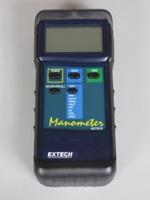 |
- Equipment used - "Extech 407910" Manometer
- General info - Suction alone must NOT be used as vacuum cleaner efficiency indicator !
Vacuum cleaner must have a good airflow and well designed intake nozzle to be effective cleaning given surface. Imagine a big suction cup - you can lift very heavy load that would be hundreds of pounds however it would not be any good if you needed to lift a feather.
There are many units used to measure suction but vacuum cleaner industry commonly uses inches of water in a U-shaped tube.
Figure 1 - u shaped tube filled with water with both ends ("a" and "b")open.
Figure 2 - same u shaped tube but this time connect a vacuum hose to end "b". Water in leg "b" will go up and in leg "a" will go down. The resulting difference "h" will be "Water Lift"
- Experiment setup - this is pretty straightforward. We use halve sphere rubber plug with hose for the tube that is being connected to the manometer. Turn on the vacuum and press the plug to the vacuum intake.
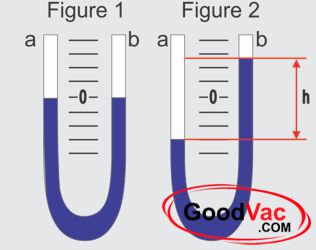 |
|
|
|
| AIRFLOW |
|
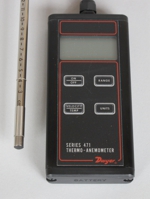 |
- Equipment used - "Dwyer Series 471 " Thermo Anemometer
- General info - Airflow alone must NOT be used as vacuum cleaner efficiency indicator !
Vacuum cleaner must not only have a good airflow but appropriate suction strength and nozzle design. Once you put the nozzle on the carpet airflow will meet resistance and if suction is weak airflow may go down to zero.
- Calculations - Equipment shows air speed in feet/min. Result needed in Cubic feet per minute:
- Calculate area of the opening in feet
Formula - (Pi times radius squared) (Pi times radius squared)
Radius is 0.65625 inch or 0.0546875 feet
A = 3.14159265 x 0.0546875 x 0.0546875
A = 0.009395632 square feet
- Calculate volume of the air that passes through the pipe per minute:
Formula - Area of the opening times air speed (units must be in feet and minutes)
We have established that area of test pipe opening is 0.009395632 square feet and we know that our anemometer is set to measure airspeed in feet per minute. Thus all we have to do is take the reading and multiply it by 0.009395632.
- Experiment setup - vacuum hose is attached to 2 feet long and 1.3125 inch inner diameter PVC pipe. In the middle of the pipe hole is drilled for airflow probe. Piece of closed cell foam is installed around the probe so once it is inserted into the opening in the pipe the foam seals space between the edges of the pipe and the probe. While measuring probe is adjusted so the gauge shows the largest reading. Fluctuation ± 120 feet/min is observed. Assuming it is due turbulence inside of the pipe and/or airflow fluctuation. impact of the fluctuation to the final result is insignificant.
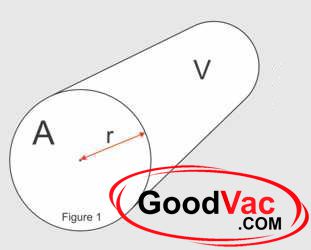
|
|
|
|
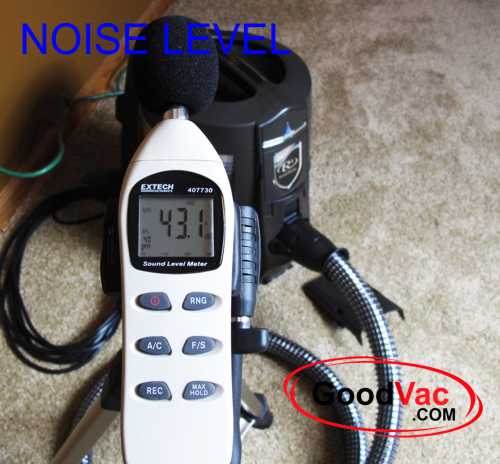 |
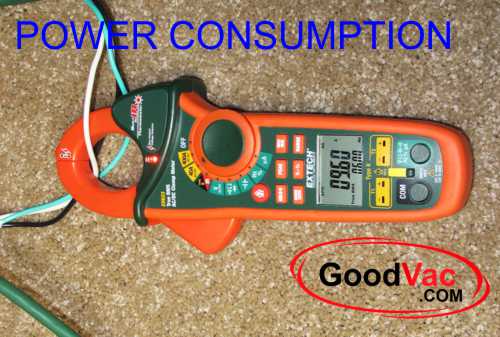 |
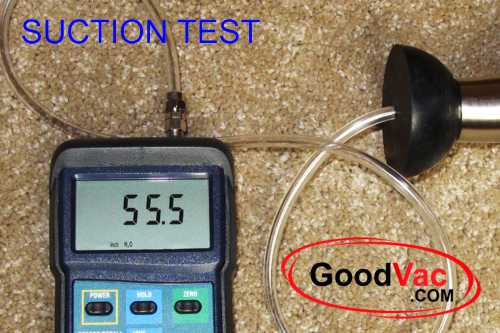 |
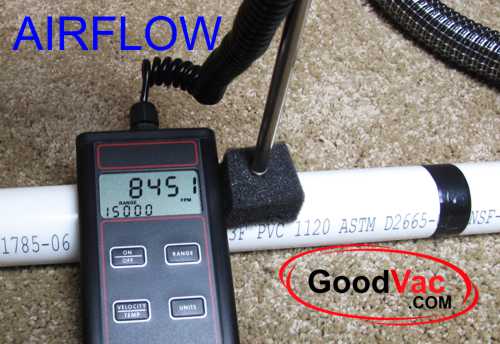 |
|